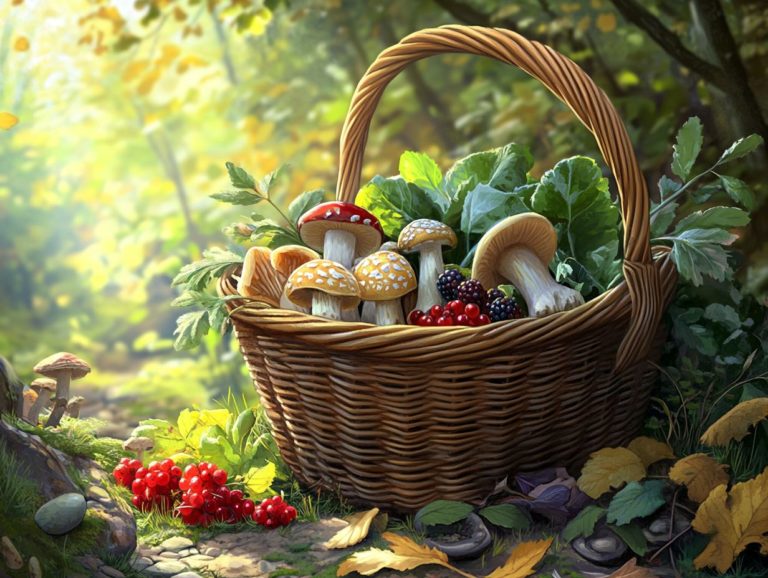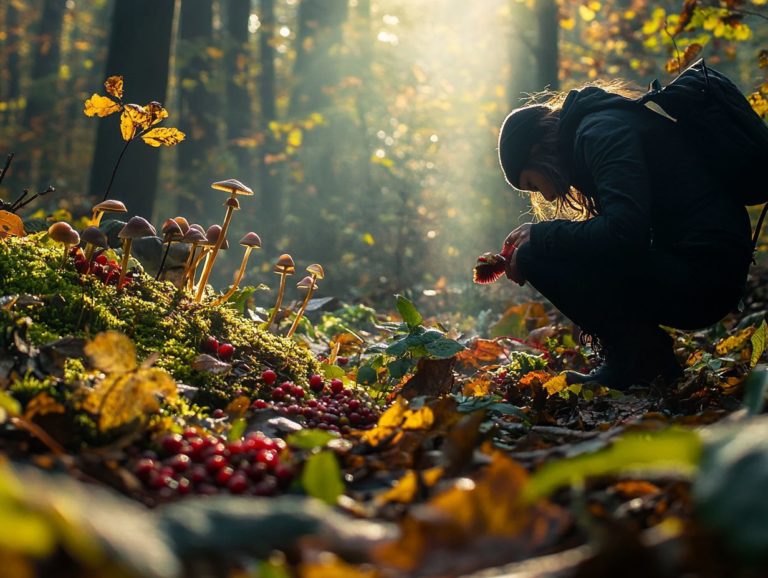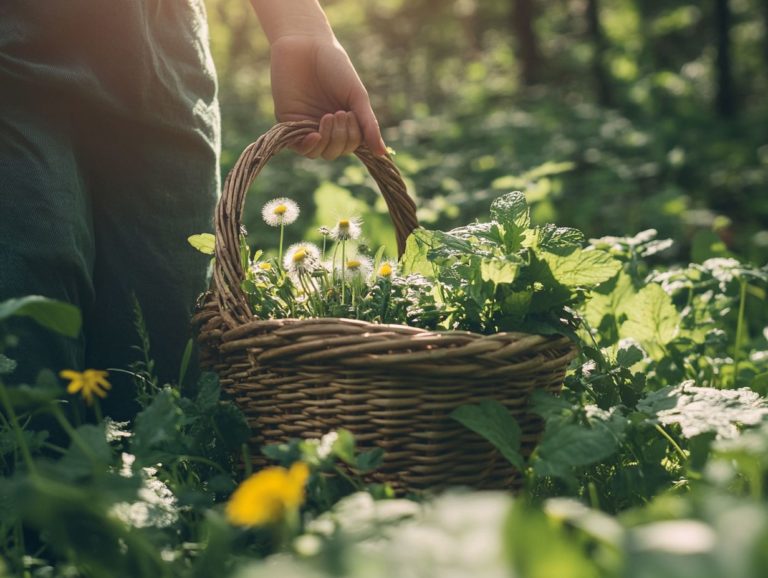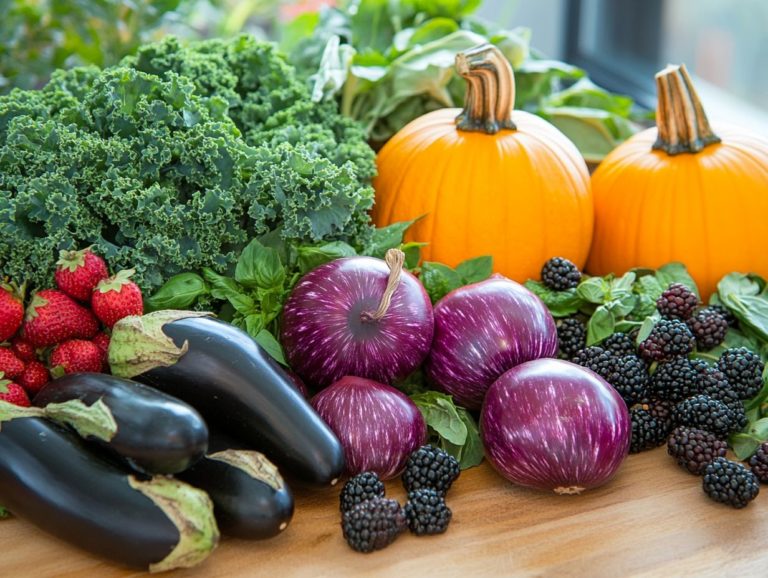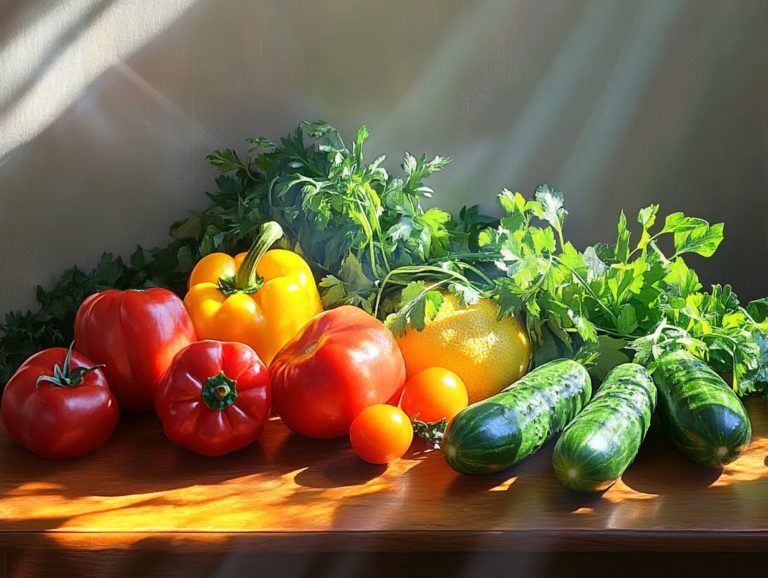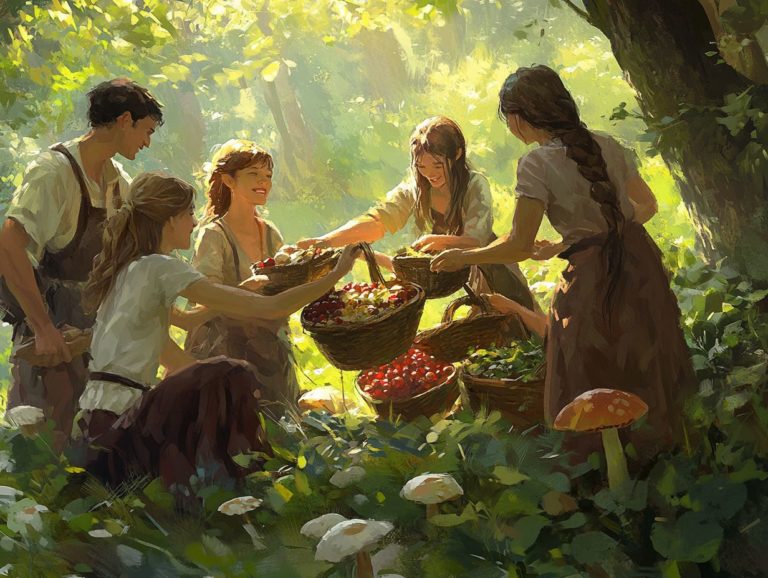The Ultimate Guide to Seasonal Foraging Techniques
Seasonal foraging and wildcrafting transcend the realm of mere hobby; they offer a profound opportunity to connect with nature and savor fresh, nutritious foods plucked directly from the wild.
You ll discover the myriad benefits of foraging, from enhancing your health to promoting environmental sustainability. Best practices for identifying and harvesting wild foods safely and sustainably will become second nature to you.
Moreover, you ll delve into the seasonal highlights what to seek out and how to prepare your exquisite finds throughout the year for a variety of outdoor meals. Prepare yourself to embark on an exhilarating and flavorful adventure through urban foraging and local landscapes!
Contents
Key Takeaways:
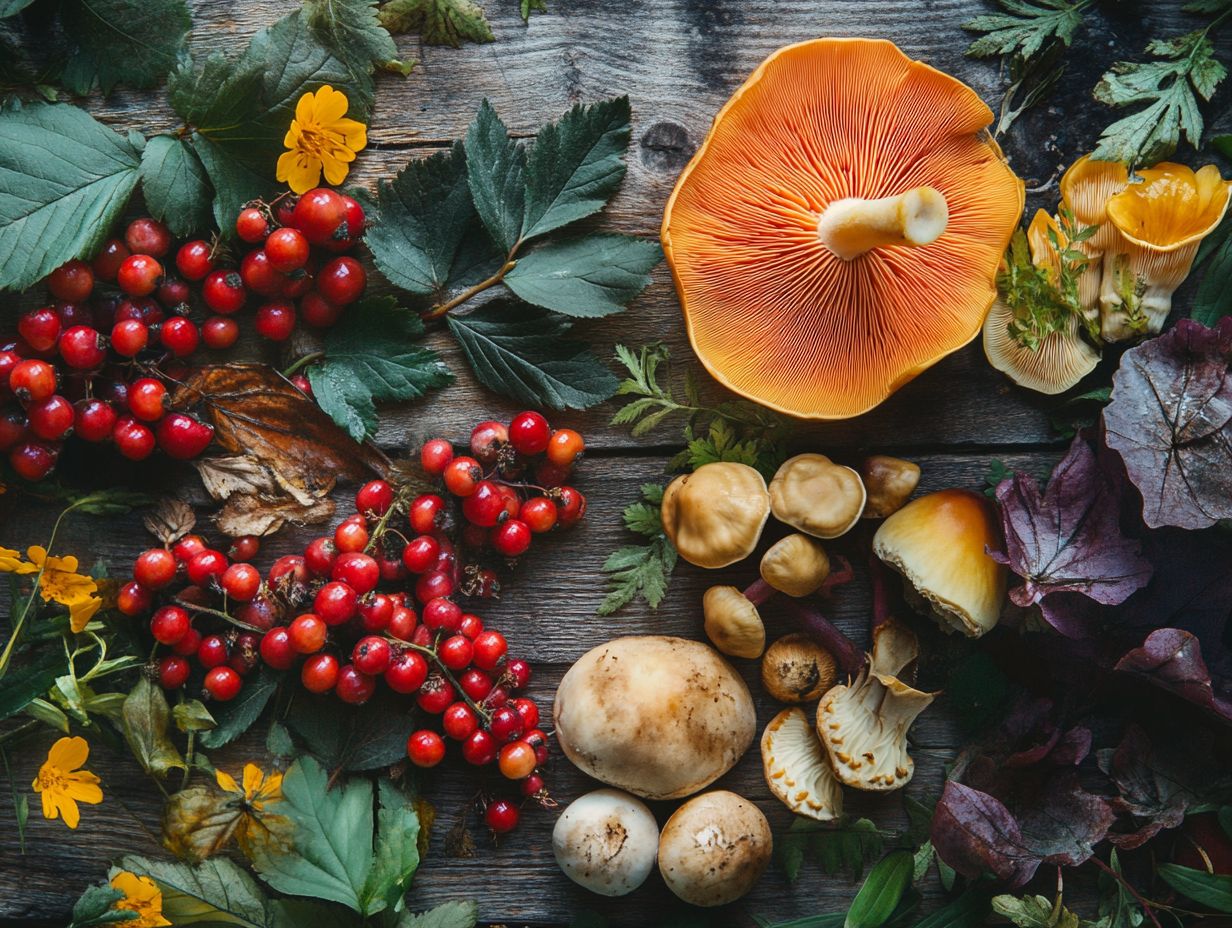
- Discover the benefits of seasonal foraging, including improved nutrition and reduced environmental impact.
- Master the best practices for safe and sustainable foraging, such as identifying and harvesting wild foods.
- Maximize your foraging potential with tips and techniques for each season, from spring greens to winter root vegetables.
What is Seasonal Foraging?
Seasonal foraging is your gateway to collecting wild edible plants and mushrooms throughout the year, perfectly timed with their natural cycles for optimal harvests. To enhance your foraging experience, consider using the ultimate seasonal foraging toolkit, which provides essential knowledge of the unique characteristics of seasonal flora and their nutritional benefits.
Engaging in this practice deepens your connection to nature and enhances your knowledge about plants and their uses. This enables you to forage safely across diverse landscapes while advocating for sustainable methods that honor our natural resources.
By recognizing which parts of plants are edible or medicinal, you gain insights into local ecosystems and their delicate balances. Foraging invites you to explore your surroundings with greater intention.
Accurate plant identification is essential it ensures you can safely relish the abundance that nature offers without risking encounters with harmful species. Ultimately, embracing seasonal foraging cultivates a sense of stewardship, underscoring the importance of preserving natural habitats.
Benefits of Seasonal Foraging
The benefits of seasonal foraging are abundant, offering both nutritional benefits that enhance your well-being while nurturing a sustainable bond with the environment.
By embracing foraging practices, you uncover a diverse range of wild foods brimming with nutrients that often outshine their cultivated counterparts.
Foraging workshops deepen your understanding of food preservation techniques, enabling you to make the most of the seasonal bounty all year round.
Nutritional Advantages
The nutritional advantages of seasonal foraging are impressive. Wild edible plants offer a rich tapestry of nutrients that can significantly enhance your overall health.
These plants are not only loaded with vitamins and minerals but also serve as a sustainable food source, helping you minimize your ecological footprint.
Embrace sustainable foraging practices and deepen your understanding of local ecosystems. This allows you to cultivate a greater appreciation for the natural resources around you.
Engaging in foraging introduces exciting varieties of flavors and textures to your meals while integrating valuable micronutrients (tiny nutrients essential for health) that are often missing from conventional diets.
By adding these exciting plants to your meals, you create a lively connection with nature! Emphasize the importance of ethical foraging methods that protect habitats and ensure these plants remain available for future generations.
Best Practices for Seasonal Foraging
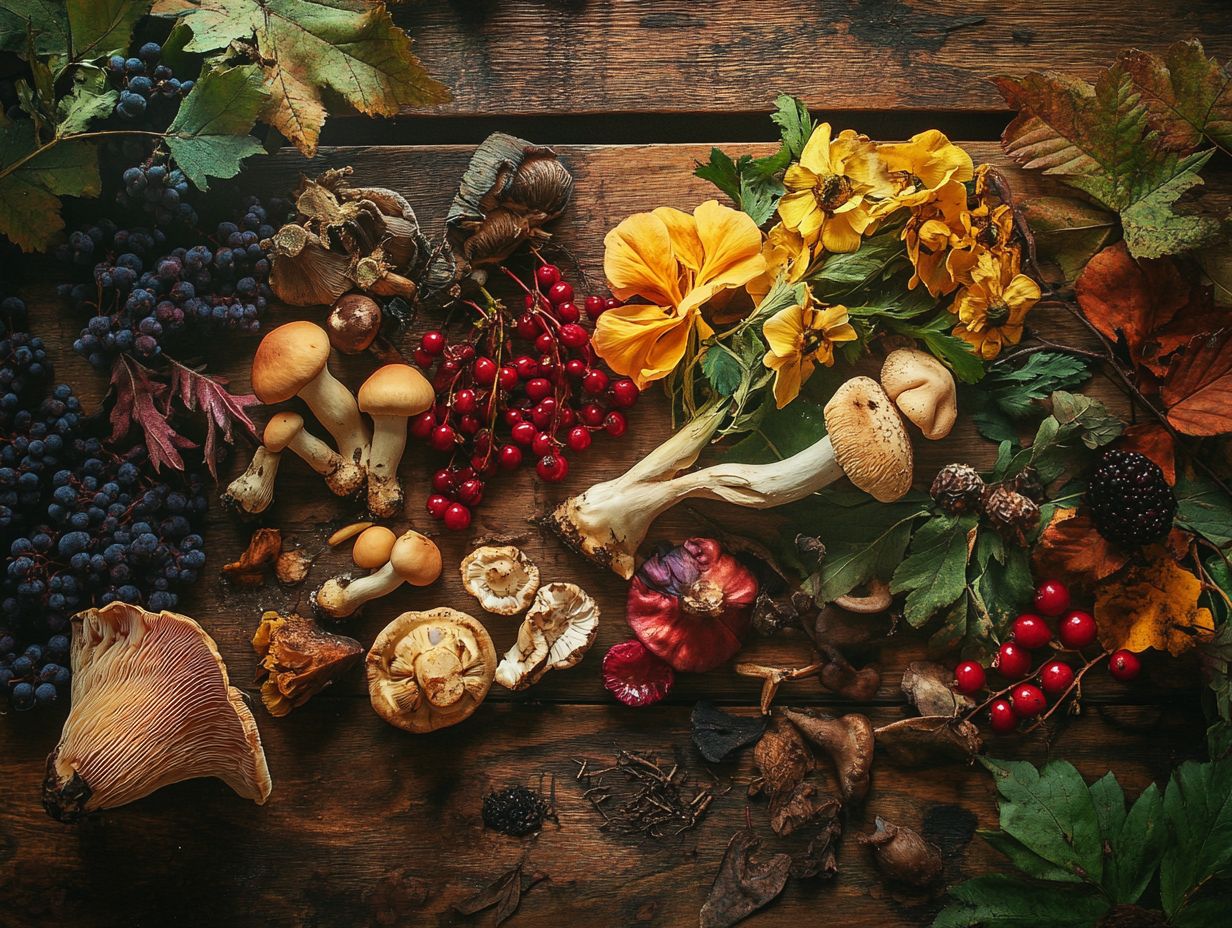
Adopting best practices for seasonal foraging is essential for your safety and the sustainability of wild edible plants and mushrooms. Mastering plant identification is key; you want to be sure which species are safe to eat, as some can be toxic, while others offer remarkable nutritional and medicinal benefits.
Understanding proper harvesting techniques and following expert foraging tips can greatly enhance your skills. Participating in hands-on foraging workshops will also boost your confidence in this enriching outdoor pursuit.
Identifying and Harvesting Wild Foods
Identifying and harvesting wild foods requires a good grasp of plant life cycles and characteristics. This knowledge lets you safely enjoy the bounty of your local landscape.
For example, wild garlic s unmistakable garlic aroma helps with identification. In contrast, elderberries appear in clusters, featuring deep purple or black berries that become highly nutritious when cooked.
Harvest carefully! Each plant you take impacts the ecosystem. It’s vital to collect only a fraction of the plant parts to ensure its ongoing growth and health.
Engaging with local foraging communities enriches your knowledge. They share insights about seasonal changes and the best spots to discover wild foods.
Staying Safe and Sustainable
Staying safe and sustainable while foraging enhances your rewarding experience. Understanding foraging safety protocols like thorough plant identification and awareness of local regulations helps minimize risks associated with consuming wild mushrooms and berries.
Practicing ethical harvesting means taking only what you need. This protects wild ecosystems and ensures future generations can enjoy nature’s bounty.
It’s crucial to leave enough plants and fungi to support regeneration. This allows ecosystems to thrive and maintain their richness, contributing to local biodiversity.
Seasonal Foraging by Season
Seasonal foraging offers exceptional opportunities to connect with nature and explore wild foods throughout the year. To make the most of this experience, refer to what to harvest, as each season brings unique plants that thrive during its natural cycle.
In spring, discover tender wild greens like stinging nettle and dandelion. Summer delights you with wild berries and fragrant herbs.
As fall arrives, harvest acorns and mushrooms. In winter, uncover resilient edible plants that thrive in the chill.
This seasonal cycle not only enhances your diet but also deepens your understanding of local ecosystems and their natural rhythms.
Spring Foraging: What to Look for and How to Prepare
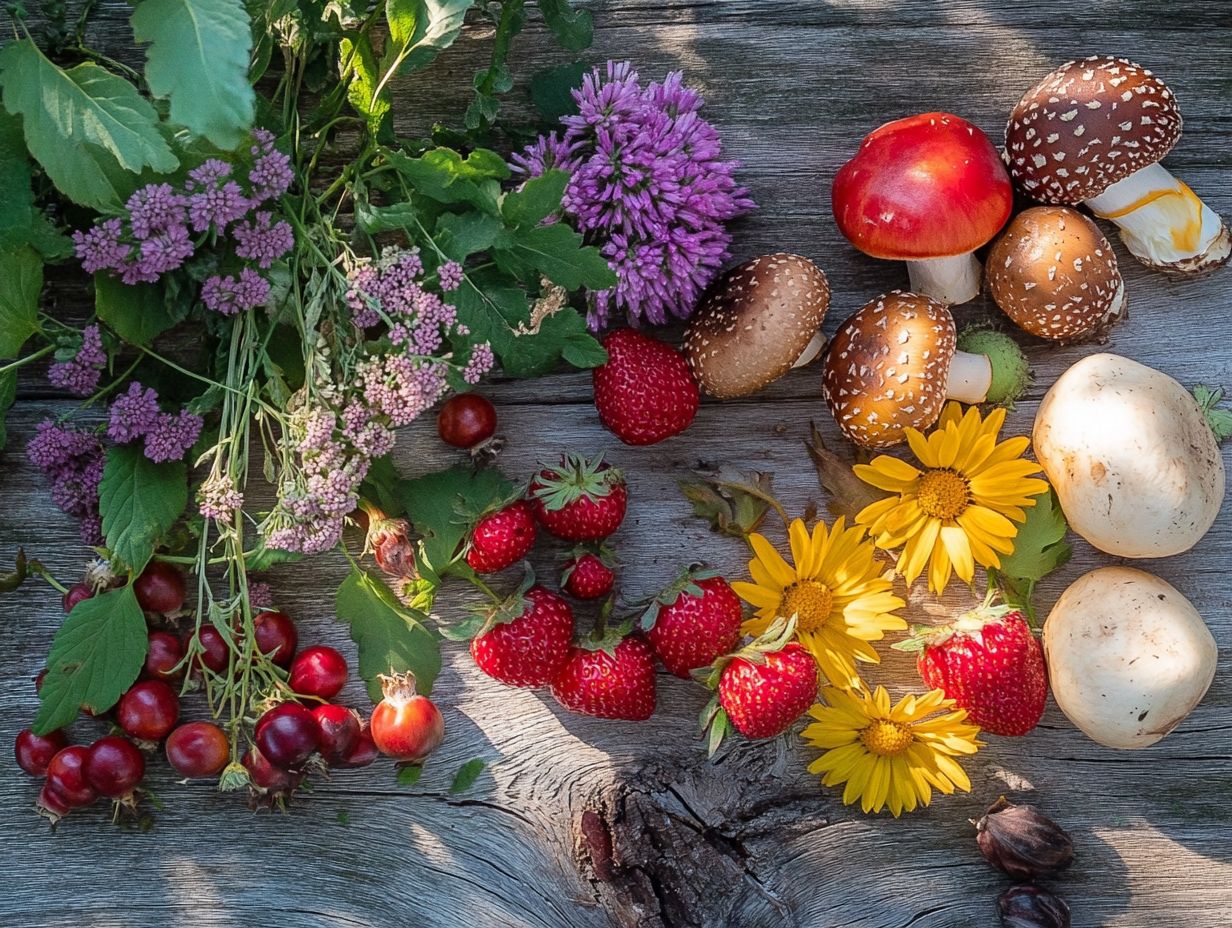
Spring foraging is an exciting chance to discover a diverse array of wild edible plants. Look for those tender greens that burst forth after winter’s retreat.
The excitement of this seasonal endeavor lies in uncovering nature’s hidden treasures. These not only invigorate your palate but also provide impressive health benefits.
As you venture into the wild landscapes, keep an eye out for these remarkable finds:
- Stinging nettle: brimming with vitamins A, C, and K
- Dandelion: renowned for its detoxifying effects and nutrient richness
- Garlic mustard: offers a delightful peppery kick that enhances any dish
Wear gloves when harvesting nettles to avoid stings. Be sure to pluck dandelion leaves before they bloom for the finest flavor.
Imagine crafting recipes like nettle soup or dandelion pesto. These dishes celebrate the season and showcase your foraged gems in spring meals.
Summer Foraging: Tips for Finding and Using Seasonal Foods
Summer foraging is an exhilarating time, brimming with chances to gather wild berries and herbs. These are perfect for elevating your culinary creations.
Keep your eyes peeled for blackberries, elderberries, and wild chamomile. Each offers its own distinctive flavors and health benefits.
Scouting near water sources and basking in sunlit spots can significantly increase your odds of uncovering these seasonal treasures. Make summer a prime opportunity for your foraging adventures.
Beyond the usual suspects, you might stumble upon wild mint, which can invigorate your summer drinks. Look for mulberries, celebrated for their sweetness and versatility in desserts.
Equip yourself with a sturdy basket for your finds and a reliable field guide for identification. This ensures your foraging experience is safe and enjoyable.
Don’t miss the chance to harvest! Always remember to leave a few berries behind. This simple act nurtures the ecosystem and ensures future growth.
Don t hesitate to experiment with preservation methods like drying or crafting jams. This allows you to relish the summer s bounty long after the season has faded.
Fall Foraging: Harvesting and Preserving Autumn Bounty
Fall foraging is an exciting adventure! It opens up a world of exquisite wild foods just waiting for you to discover.
Imagine harvesting a delightful array of treasures like wild mushrooms and acorns. These are essential for gearing up for the colder months ahead.
Picture yourself collecting seasonal gems such as chanterelles and hazelnuts. These will elevate your autumn meals.
Mastering methods to keep food fresh for a long time will ensure you can relish the vibrant flavors of these finds throughout the year.
Consider techniques like drying, fermenting, or crafting your own wild nut butter. This helps maximize the bounty that fall foraging offers.
But don t stop at mushrooms and nuts! The wild offers a plethora of fruits, including juicy blueberries and wild grapes. These are perfect for adding unique sweetness to jams or desserts.
Dandelion greens bring a peppery zing to your salads and stews. They make a versatile choice for any aspiring chef.
As you dive into preservation, think about pickling wild garlic or whipping up a hearty wild berry compote. These can be lovingly stored in jars.
This way, you can savor the essence of fall in every bite, long after the season has slipped away.
Winter Foraging: Techniques for Finding and Using Winter Foods
Winter foraging may appear daunting, yet it presents a remarkable opportunity to uncover resilient wild edible plants that flourish in the colder months, such as wintercress and various wild greens. By understanding the plant life cycle, you can easily identify which species remain available during winter. This knowledge offers a sustainable and nutritious food source.
Utilizing effective foraging strategies like exploring sheltered areas or proximity to water sources can lead to fruitful winter foraging excursions. These strategies allow you to maintain a connection to nature even in the chilliest of seasons.
Beyond wintercress, you might encounter dandelion greens, which are a good source of nutrition with essential vitamins A, C, and K during winter. These plants not only enhance your meals but also serve as excellent sources of antioxidants.
To make the most of your winter foraging adventure, consider bringing along a field guide like the top 5 regional foraging guides you need. This can sharpen your identification skills and deepen your understanding of what the plants can do for you. Flexibility is essential; be prepared to adjust your foraging locations based on weather conditions and timing to enhance your yield.
Embracing this adaptability can unveil delightful surprises. It can enrich your culinary repertoire while honoring the generous offerings of nature.
Frequently Asked Questions
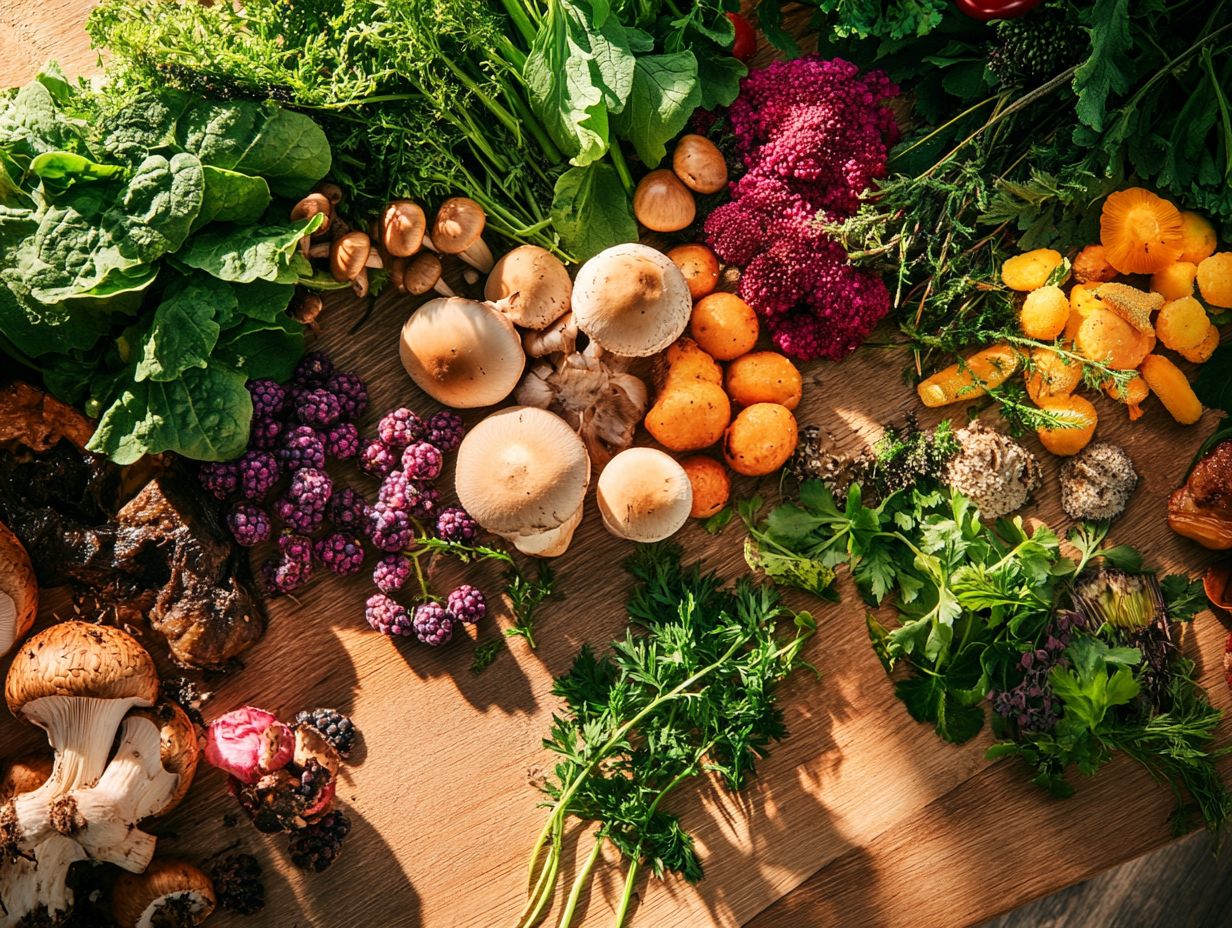
What is foraging?
Foraging is the practice of gathering wild plants and other natural resources for food, medicine, or other purposes.
Why is it important to forage seasonally?
Foraging seasonally ensures that you are gathering plants and resources at their peak ripeness and nutritional value. It also helps in respecting the natural cycles of the environment.
What are some common seasonal foraging techniques?
Common seasonal foraging techniques include identifying and gathering edible plants and fruits. For more insights, check out what to know about seasonal foraging in your area. You can also collect nuts and seeds, using tools such as digging sticks or baskets.
How can I learn more about seasonal foraging techniques?
The best way to learn about seasonal foraging techniques is to research and study local plants and resources. Additionally, exploring top resources for sustainable foraging can enhance your knowledge. You can also join foraging groups or classes and practice with experienced foragers.
Is foraging legal?
Foraging laws vary by location, so it is important to research and understand the regulations in your area before foraging. Some plants may be protected or require permits to gather.
What are some safety considerations when foraging?
It is crucial to properly identify plants before consuming them. Be aware of potential allergens or poisonous plants. Always wash and prepare foraged foods properly before eating.

